Site 3 Dr. Ross Moore
The Dust of Words: Christian Capurro's Squandered Vogue
Text of a talk written by Ross Moore and performed by Penny Trotter at the, the Salvation Army Family Store, Abbotsford, at 3pm on Saturday April 24. This being the third site of the AMPEdS project in Melbourne, Australia, in 2004.
THE WORK OF ART AS ENTROPIC MANIFESTO OF POLITICAL ECONOMY
Working out from Bataille, particularly his The Accursed Share, Volume 1 in which he proposes “I had a point of view from which a human sacrifice, the construction of a church or the gilt of a jewel were no less interesting than the sale of wheat” we come to the notion that the erased book might be an equally exquisite example of a “general economy” in which the “expenditure” of wealth, rather than production, is the primary object1.
How might the strenuous and in its own way ascetic rigor of rubbing (art as annihilatory frottage) work to achieve a state of entropic blankness in which the promise of productive labor would be so perfectly, so absolutely, so catastrophically evacuated?
Not only this, how might this so strenuously achieved nullity fail to redeem itself by translating into radiant catharsis, some desublimated ascesis, even a cynical post-modern apotheosis, remaining instead, a mere gloss or reflective smudge, the vestige of a scramble but speaking finally to nothing other than to the conspicuous because spectacularized scene of the necessarily wasteful consumption of superabundance?
Welcome to the artworld and its concordance to the magnificently manic ceremonies of Aztec human sacrifice!
Christian Capurro’s squandered because always already luxuriously top-end Vogue magazine with its 246 erased pages (including Sylvester Stallone cover), and its 267 hours 49 minutes and five seconds of labor worth AUD$11,349.18 (as invoiced by the participating artists and of course they weren’t properly paid!) proposes that artwork, working that is, at art, is merely another frenzied case of using up all waste energy.
Of course this casts a peculiar theatrical shadow over the installation’s present location: a Salvation Army Opportunity Shop with its own strange insistence that it is not only possible but necessary to garner new life, fresh opportunity, or at least, recycle the bones of dead life from the accursed share - that excessive portion that society must be seen, conspicuously, explosively, to entirely spend.
All these hours of making art are surplus machinations circulating on the surface of the globe. Like war, like the medieval monastic system of Tibet, art is unnecessary for the growth of the system and so will be, as Bataille insists “lost without profit; it must be spent, willingly or not, gloriously or catastrophically”2. The labor of rubbing out Vogue - an iconophilic catastrophe of a sumptuous kind - is therefore twice forfeited - once for deigning to be artistic and again for hoping to make it pay!
In this way we are confronted with material reality rather than symbolic or ideal analogies. The blank pages with their vestiges of animal spoor and semiotical scramblings function as actual drains, machinic sluices or, if we calculate the agonies of boredom and demands for proper completion and other sado-masochistic rules, perform as torture machines, killing assemblages, to siphon off the excess wealth of living nature that is bound to escape and “be lost to us” just as the Aztecs ritualistically decanted their own superabundance by ripping out the still beating hearts of slaves and holding them aloft to that divine motor of profligate climacticism: the radiant sun with its obscenely exuberant light streams!
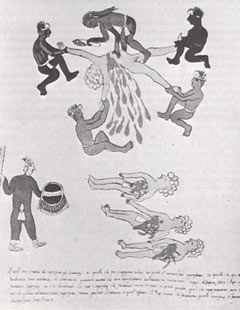
So if there is something already exhausting in our account of Capurro’s collaborative “magazine-artefact” as he names it, this serves to only better capture Bataille’s anti-teleological claim that there is generally “no growth but only a luxurious squandering of energy in every form!”3
Which brings us back, in the only apparently oddest of ways, to the initial proposition: that by speculating on the meaning of a rubbed out Vogue one is led to the grisly economic mystery that we can only trace - artistically or not - does it even or ever matter? - the “exhausting detours of exuberance through eating, death and sexual production.”4 For what has been erased so zealously on these pages are these same master-insignias rendered as advertisements for Joop fragrances for men; The Real Male Essence; 101 sexual tips for the ideal lover; Oprah’s childhood sexual abuse; Ali’s hypnotizing charisma; Morocco Modern on a shoestring; You can Beat Breast Cancer; Sushi Surprise; Sizzling Sichuan etc. etc. Commodification ad infinitum.
The achieved blankness, folding over itself in a weird act of multiple effacements, perversely announces other rubbed out stories about critical food shortages in Zimbabwe and the Sudan, the bombing of Palestinian children etc. In this way the museological affectation of the vitrine housing or protecting (even deifying) the erased book takes on a quality at once monstrous and scientifically correct. Just as does indeed, this Op shop with its detrital remains arranged into convenient patterns of charitable order, yet other people’s left-overs, flamboyant trophies, all the same.
NOTES ON TOM FRIEDMAN: THE HUMAN AS COPROPHAGIC GRAPHIC TRACE
Let’s step sidewise to consider, for a moment, the work of Tom Friedman whose fascination with what he names “obscenely white, empty space” together with a Post-Platonic questioning of whether art is findable or bears its yields beyond the logistics of representation, nicely reverberate Capurro’s own.
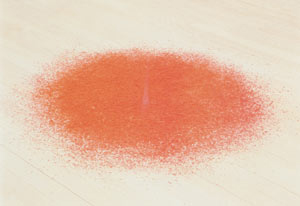
Tom Friedman, Untitled 1990
eraser shavings, diameter 36 inches
courtesy of the artist, Conway MA and Feature Inc. NY NY
I am thinking of his Untitled 1990, a dimensionally variable mound of apricot coloured eraser shavings on the gallery floor - inversely reminiscent of the hazelnut pollen piles of Wolfgang Laib - for here it would be artifice that is working back to nature not the other way around. Then there is his 1992 wall sculpture titled Pencil Shaving - created by completely shaving a pencil into an elongated spiral strand; his pinned up piece of paper titled 1,000 Hours of Staring (of course it was only “finished” upon the lapse of that exact but arbitrary time) and his 1992 work, Erased Playboy Centerfold - you guessed it - an erased Playboy centerfold hung on the wall by a solitary pin.
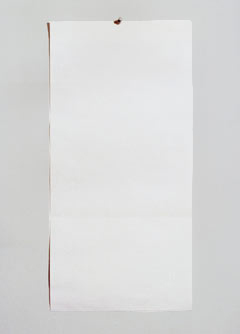
Tom Friedman, 11 x 22 x .005, 1992
"Playboy" centerfold, 22 x 11 x 0.005 inches
courtesy of the artist, Conway MA and Feature Inc. NY NY
In all these works an obsessive yet eloquently simple hand-driven logic of mechanical production/reproduction is mapped across a hyper-refined blankness that would be the art object’s own ability to annul or internally dissolve itself - to render itself mute, self-absent, that is, as an autonomous and ontologically secure object-hood.
In his survey essay on Friedman, Bruce Hainley suggests that, putting aside the “oedipal machinations” of desecrating the work of the Father, we can extend the logic of Robert Rauschenberg’s Erased de Kooning Drawing, 1953 to consider Freidman’s own work:
“(T)he single erasing gesture itself allows more than two things to exist: the idea of the de Kooning drawing in memory (the site of most seen things); the actuality of its absence; and the presence of its absence as a Rauschenberg.”5
But all these spectacularizing implications of a single erasive gesture revolve around the notion of the possibility or better still likelihood, of being a “self” together with how that might be transacted, destroyed and reinvoked as a machinic trace.
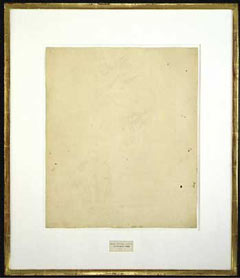
Robert Rauschenberg, Erased de Kooning Drawing, 1953
traces of ink and crayon on paper, and gold-leaf frame, 19 x 14.2 inches
San Francisco Museum of Modern Art, San Francisco
Hainley interestingly proposes that Friedman’s interests are perhaps not so much about the psychological or psychologizing trouble some people have “knowing whether or not they exist,”6 but rather, aim to question the very nature of what it means to be matter. Which makes it a matter, quite literally then, of matter:
Friedman’s tests - of what matter is by allowing it almost not to be (e.g. the pin pushed into paper until it’s dentelle lace and with any more pin-pushing no longer paper at all) - call into question the nature of the test. If Deleuze and Guattari’s body-without-organs provides a way of depsychologizing Friedman’s use of his own body as a nomadic thing (its materiality the stuff of dreams and resolutely just stuff, like a block of wood), the body with all its organs proves just as pertinent.7
But it strikes me that the multiple but invisible fugitive body in Capurro’s work - a dessicated or empty Body-Without-Organs - especially when it is itself turned into an appalling global equivalence by being reduced to so many hours worth so many dollars - invokes peculiarly Marxian speculations regarding use and exchange value and the accompanying issues of commodity fetishism and alienation.
But having said this - and isn’t it too obvious? - might we not also employ a Deleuzian reading to capture, at least momentarily, the multiple modalities of the erased book as itself a forever escaping nomadic character - a collective assemblage of enunciation for which there “isn’t a subject”?8
For what the erasure of the printed contents of an entire Vogue does is engineer an act of deterritorialization whereby the varieties of patois asked to work - and entertain - the totalitarian demands of consumerist individualism (the paradox of this imperative for self distinction via mass packaging is inherent to capitalism) are disarticulated, reduced to so much litter, to so many “sign-particles” emitted in ink and Oedipally sedimented upon the vector of the page and hence susceptible to being erased at any moment not at the level of semiotics but at the entropic level of the radical disorganization of all forms - whether the ready-made forms of expression or the ready-made forms of content. All are so much stuff or lumpen to invoke again Marx, and Op Shops, for the grinding frottage mill.
Thus, rather than engaging in melancholic retrievals of the dust of words according to some organized parental authoritarian bid to reconstitute the principal strata that “bind and imprison the human being”9 not to mention articulate, along simulacral lines, content’s own logothetic expression by seeking to reassemble, imagistically reconstitute the pages that have been, like so much kitsch, censured and lost, Capurro’s mass erasure (for many choice or chosen consumers were involved) performs an “absolute deterritorialization of the cogito” of not just the mediated self but of the corporation’s own body: its entity as media.
Here then is a new machinery of monstrously incommensurate social operations: a cannibal book capable of taking over, even whilst anticipating, the material. All material. The significatory material, the representatory structures that, is, of all primary expression.
What need to speak then of cultural melancholy, the shattered Benjaminian aura, the final operations of taste, and the plight of the various sickeningly over-determined species of kitsch?
THE ERASED PAGE AS COLONIAL PRIMAL-SCENE
Given our immediate Australian setting - the brown Yarra River is flowing - usually sluggishly, just outside this door - and given that the book is mounted as a freakish albino taxonomic specimen, we might also wonder, along another line of destratification, and especially if trained in the dialectics of negative theology, whether the use of whiteness as a blinding exposure, or the exposure of blindness as a blazing whiteness, refers back, in the mode of a scrapping through epidermal layers or screens, to the roots of a primal scene: to old antique matters of empire and colonial heroics together with their at least eventual unrecuperable failure - a failure, indeed, assured inevitably, by any extreme cultural myopia, or refusal, in the name of monomania, of heteroglossic relativism!
Without wishing to venture, Derrida-like, into the metaphorics of whiteness (but venture we must) we can altogether more crudely speculate how the fastidious erasure of the magazine’s contents establishes, or, in a psychic sense implants, as its own unconscious excremental evidence, a luminous hiatus, a fertile aphasia in the ruined and ruinous name of the deliberate, nay wilful, or perverse iconoclastic erosure (or maybe it is just a theatrically pretend or hyperbolic erasure), of that imagistically loaded tabloid juggernaut, or clambering literate beast that is so distinctly white commodity culture.
Considered in this way, via Brunos Latour’s portmanteau notion of “iconoclash,” a “matter” of whiteness would not be the aftermath of any rubbing out, usually violently, with slashes and smears, identity’s face (or should that be faces)? Not to mention any number of so vigorously coloured lives?10
Rather, it would be revealed - by working painstakingly back, here in art’s own name along the grooved grain of an inevitably eugenic trajectory of white labor - as nothing other than the monstrously bland (or blank-faced) preta-condition from which an interminable and thus blinded out-to-itself eternal whiteness springs or, better still, laterally erupts, for in this model of representational domination no real depth is ever really permissible.
What Christian’s rubbing - dare we now say the rubbing of a Christian? - finally achieves is merely what only ever came before.
This installing of the result in or as the cause is the very stuff of a genealogy. A veritable and thus appallingly vigilant tabula rasa, a proverbial terra nullius then, folding and spreading itself out (for in a colony space is, like gold or ivory or measured seal skin, at an absolute premium) again and again, over itself, in the prehistoric manner of a flat animal, say a pre-invertebrate worm, or an organic blond ectoplasm that wonderfully arrives - but actually, like strictly blond Alice in Wonderland, never really gets to go anywhere - according to the vertiginous economy of the mobius strip - the true rhetorical figure of a colonial narcissism, not to mention the eroticized self-narration of a self-consciously white media machine.
Richard Dyer claims in his study of whiteness as racist representation, and to pursue the point a little more painfully (for we also have a vested antagonistic stake) that white is always already cast as numinous figure of precedence or, more literally again, presidential whiteness. This follows on from the point, as Dyer expresses it, that “white people have had so very much more control over the definition of themselves, and indeed of others than have those others.”11
But doesn’t this granting of such a powerfully assertive role for white people - functioning as successfully despotic signifiers - merely perpetuate the conceit that whiteness would somehow have a productive monopoly or effective tyranny over culture? Elaborating a masterful beige against which no other can properly speak?
Recall Franz Fanon’s famous childhood scene described in Black Skin White Masks in which he first recognizes his body in the third person - or rather, his body “in a triple person”:
“Look a negro!” It was an external stimulus that flicked over me as I passed by. I made a tight smile.
“Look, a Negro!” It was true. It amused me.
“Look, a Negro!” The circle was drawing a bit tighter. I made no secret of my amusement.
“Mama, see the Negro! I’m frightened!” Frightened! Frightened! Now they were beginning to be afraid of me. I made up my mind to laugh myself to tears, but laughter had become impossible.12
An experiental erasement then by which the boy was “called on for more.” So not a neutral whiteness but an Althusserian cry for “the miserable Negro to whiten himself and thus to throw off the burden of that corporeal malediction.”13
But Fanon did reply to “All this whiteness that burns me.” Against the fiery scorching whiteness that weaves Fanon’s body “out of a thousand details, anecdotes” he weaves his own stories and elaborates his new body out of them. And who is to say this was merely reactive? Nothing other than a gesture of Bad Faith? Some pathetic articulation of ressentiment?
THE ERASED MAGAZINE AS ANDY WARHOL’S FACE
To cut a long colonial story short, and to introduce yet another line of flight, I suggest it is part of the corrosive anomaly of Capurro’s rubbed out popular magazine - its distinctly political efficacy if you may - that it would not behave according to the Hegelian dialectical model of recognition structures reliant as they are upon the internally grappling dyad of master/slave (for why should the non-white even have to reply to a forever demanding whiteness?) but that it would operate according to the deconstructive machinery of differance - what Eve Kosofsky Sedgwick calls Queer performativity in her pertinent essay, Queer Performativity: Warhol’s Shyness/Warhol’s Whiteness.14
Actually, it is not at all gratuitous to draw in the shockingly white visage of a preta-naturally pasty skinned silver-shock wigged Warhol for can’t we equally refer Capurro’s doctored magazine to Warhol’s own Queerly - meaning too white - to the degree of a hallucinatory mirror shimmer - performativity? His equally obsessive efforts, that is, to so precisely make himself over - or make himself up - as a reductive recalcitrant yet ostentatious blankness - the very calculated hyper-white precision which, as Sedgwick puts it, puts him to service - like indeed this blanched and equally over-invested and excessively under- or de- signified book - as a “sharp heuristic chisel to pry at the faultiness and lay bare the sedimented faces of his surround.”15
Thus Warhol’s sheer visage as itself machinically erased book comes to stand as a kind of rapture - a “denuding sculpture at once so intimate, so public.”16
And the ghosted book, like Warhol, working as razor-sharp insinuative device, comes to hover, shimmering, at the threshold of simultaneously evacuated and invoked presence. At the boundary of public exhibition with their promise of applauding audiences and a manic shyness that would require the withdrawal of the self, as itself artistic artefact, from the too-interpretable domain of texturality and its accompanying vulnerability to semiotic promiscuity and potentially murderous scrutiny. Remember gun-toting Valerie Solanis and her 1967 Scum Manifesto.
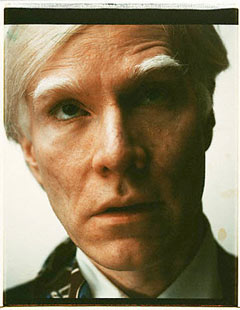
Surely Warhol’s radiant seamless whiteness is an abject sublime cast out in the disembodied or displaced form of anti-scum.
Whiteness then as traumatic always-returning screen memory and paranoic mimeticising camouflage or chameleon skin. A variety of legendary psychasthenia17. A medium seeking to submerge and hide itself in the horrifically thin mirror space of yet more compulsively significant appearances and still more imagistic - read tabloid - proliferation.
Thus the pumped-out glossy factory magazine would - in its own still singing, still floridly performing denudement - its eraser-sharp desecration - its manically manicured dishevelment via repeated strokings and discombobulating rubbings - despite its initial claims to puritanical clarity and reposed ascetism - come to ever so ripely stand as that “shimmering ambiguous, shame-charged linguistic space of utterance and address”18 that would capture Warhol’s own shy attention-seeking ambivalence, his shunting backwards and forwards as he watches his luminously transparent skin for the subterranean emergence, or pathological significatory irruption, this so dreadfully mobile publication of tell-tale somatic yet also semantic markings, that would render him, reveal him as other than uncannily missing, uncannily absent:
Day after day I look in the mirror and I still see something - a new pimple. If the pimple on my upper right cheek is gone, a new one turns up on my lower left cheek, on my jawline, near my ear, in the middle of my nose, under the hair on my eyebrows, right between my eyes. I think it’s the same pimple, moving from place to place. I was telling the truth. If someone asked me, “What’s your problem?” I’d have to say, “Skin.”19
The skin of the white page or the page as white skin. That “index of color or no color, of luminescence, of transparency/opacity, and of the natural/unnatural.”20
If Warhol offers, as Sedgwick says, “the literalizing allegory of whiteness”21 then the whiteness of his flesh color that doesn’t resemble any human flesh - humans can only approximate it - the hyperbolic transfigurative whiteness of the erased book also configures as it literalizes, literally, the prohibitive structures through which, through skin, any identity, even that of a pimple, crystallizes, as a disturbance, or blemish, or frottage tracing, into social full-scale potentially rampant being. Let’s not mention the alienated split-off subjectivity pertaining to global production.
And if the pimple might be found wandering nomadically beneath the skin, wondering just where to pop up next, like some histrionic marker, broadcast beacon, might not this absent book also be found, pimple-like, readying itself for its next cultural manifestation? The accursed share as glass-boxed blot irrupting with just the faintest reflective pink blush, on the artistic landscape?
Footnotes:
1Georges Bataille, The Accursed Share, Volume One, translated by Robert Hurley, Zone Books, New York: Zone Books, 1991, p. 9. He writes: “Indeed, I had to add that the book I was writing (which I am now publishing) did not consider the facts the way qualified economists do, that I had a point of view from which a human sacrifice, the construction of a church or the gift of a jewel were no less interesting than the sale of wheat. In short, I had to try in vain to make clear the notion of a “general economy” in which the “expenditure (the “consumption”) of wealth, rather than the production, was the primary object of wealth, the “consumption” of wealth, rather than production, was the primary object”.
2Bataille, op cit., p. 21.
3Bataille, op, cit., p. 33.
4Ibid.
5Bruce Hainley, Dennis Copper and Adrian Searle, Tom Friedman, Phaidon Press: New York, 2001, p.62
6Ibid.
7Ibid.
8Gilles Deleuze and Felix Guattari, Kafka: Toward a Minor Literature, translated by Dana Polan, University of Minnesota Press: USA, 1986, p. 18.
9Ibid.
10Bruno Latour, editor, Iconoclash: Beyond the Image Wars in Science, Religion and Art, ZKM Centre for Art and Media, Karlsruhe, The MIT Press: Cambridge, Massachusetts, 2002.
11Richard Dyer, White, Routledge: London, p. xiii.
12Frantz Fanon, Black Skin White Masks, translated by Charles Lam Markmann, Paladin: Frogmore, 1973, p. 79.
13Ibid.
14In Pop Out: Queer Warhol, edited by Jennifer Doyle, Jonathan Flatley & Jose Esteban Munoz, Duke University Press: Durham and London, 1996, pp. 134-44.
15Sedgwick, ibid., p. 135.
16Ibid.
17Callois, Roger, “Mimicry and Legendary Psychasthenia” October 31 Winter (1984), p. 17-32.
18Sedgwick, op. cit., p. 135.
19Ibid., p. 136.
20Ibid., p. 139.
21Ibid., p. 138.
Dr Ross Moore
Theory of Art and Design
Monash University
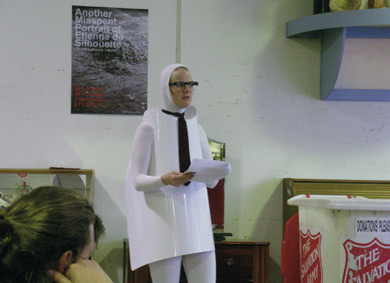
Penny Trotter delivers Ross Moore's text
His PhD was titled Anal Vision and was an extensive investigation of anality as a desiring regime that might upset ocularcentricism. His most recently presented conference papers dealt with the work of Keith Boadwee who paints with his bottom and anal imagery (particularly sodomized mermen) found in the margins of illuminated medieval texts.
His current visual work deals with post-coloniality and works out from 1950s Australian salt and pepper shaker design. This makes him a perpetual hunter in opportunity shops. His earlier work on this theme, the 1994 installation Dear Primitive: Black Bodies, is in the collection of the Queensland National Gallery.
Penny Trotter is a performance artist and lecturer in Art and Design at Monash University.
